Ann Linnea - Keepers of the Trees
Download as pptx, pdf0 likes206 views
Trees provide vital benefits but face threats; communities are forming to care for and protect important trees. People support trees and each other in their important work of environmental stewardship.
1 of 35
Download to read offline
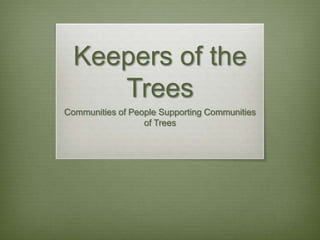
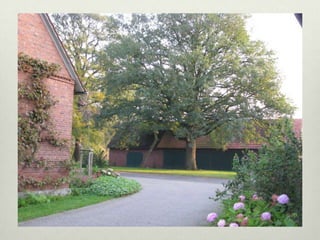

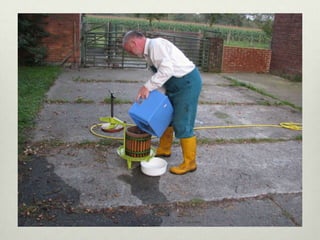

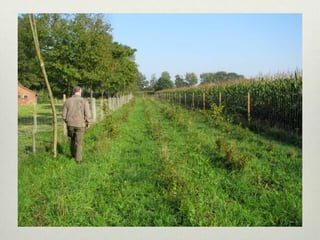
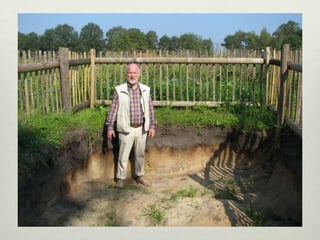


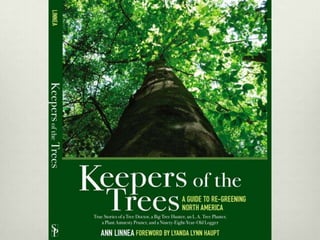

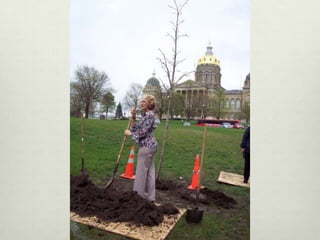
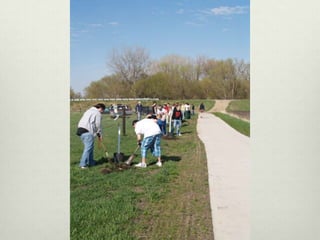
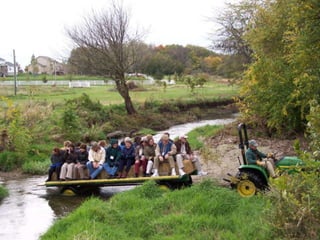


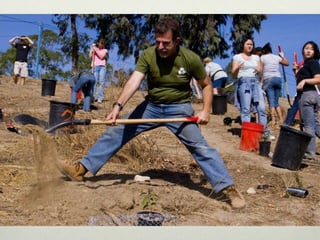
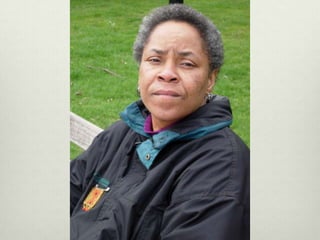
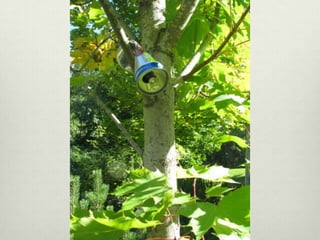
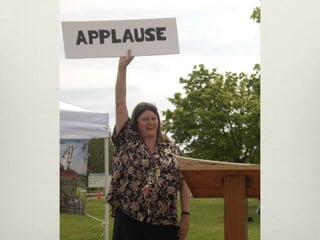






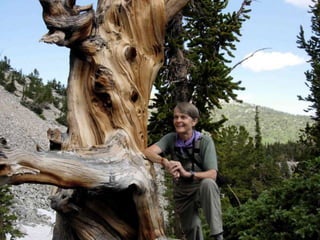
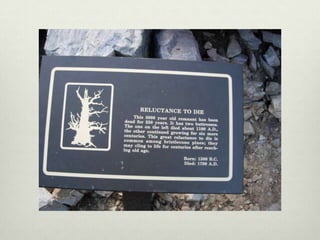
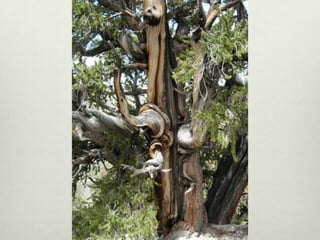
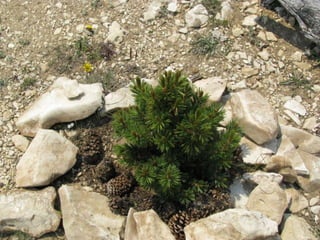
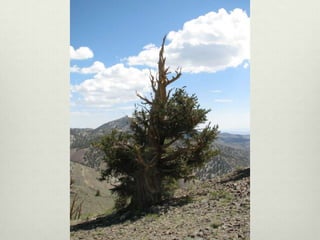
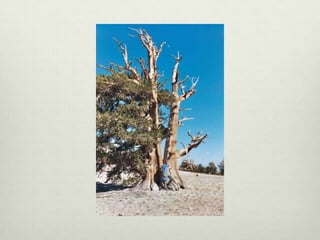

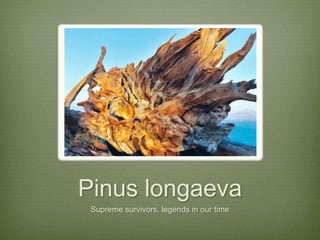
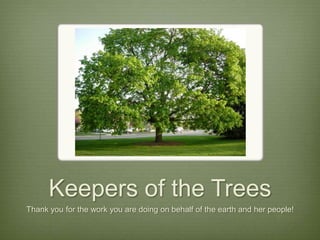
Ad
Recommended
T600 20110225
T600 20110225Chris Eller
╠²
This document discusses the development of a new 3D advanced production class. It provides background on the history of 3D technology and movies. It then outlines the goals, challenges, and approach of the new class, which aims to equip students with the skills to work in the growing 3D film industry by developing the first curriculum to teach 3D storytelling and production. Key challenges include developing new pedagogical approaches and assessments for 3D, as well as obtaining the necessary 3D equipment.Hippos
Hipposjheil65
╠²
The hippopotamus is a large semi-aquatic mammal known as the hippo. It spends most of its day sleeping on land but goes into the water to avoid the sun, where it can stay submerged for 3-5 minutes with its ears and nostrils closed. Hippos secrete a reddish oil from their skin that was once mistaken for blood, and males compete for mates by fighting and biting each other during mating season.02 diversity of_life_and_clas
02 diversity of_life_and_clasJAWAHAR NAVODAYA VIDYALAYA KANKER
╠²
This document discusses the classification and diversity of organisms. It outlines the taxonomic hierarchy from kingdom down to species. The five kingdom system is described, including Bacteria, Protists, Fungi, Animals and Plants. Key characteristics of vertebrates and invertebrates, as well as non-flowering and flowering plants are summarized. The taxonomic groups discussed provide an overview of the classification of life on Earth.Ó╣Č─ÓĖłÓ╣ēÓĖ▓ÓĖ½ÓĖ╚©╣ēÓĖ▓ÓĖŚÓĖĄÓ╣łÓĖÜÓĖŻÓĖ┤ÓĖ½ÓĖ▓ÓĖŻÓĖćÓĖ▓ÓĖ╚©ĖäÓĖŁÓĖĪÓĖ×ÓĖ┤ÓĖ¦Ó╣ĆÓĖĢÓĖŁÓĖŻÓ╣ī
Ó╣Č─ÓĖłÓ╣ēÓĖ▓ÓĖ½ÓĖ╚©╣ēÓĖ▓ÓĖŚÓĖĄÓ╣łÓĖÜÓĖŻÓĖ┤ÓĖ½ÓĖ▓ÓĖŻÓĖćÓĖ▓ÓĖ╚©ĖäÓĖŁÓĖĪÓĖ×ÓĖ┤ÓĖ¦Ó╣ĆÓĖĢÓĖŁÓĖŻÓ╣īÓĖøÓĖŻÓĖ░ÓĖ×ÓĖ▒ÓĖÖÓĖśÓ╣ī Ó╣ĆÓĖ¦ÓĖ▓ÓĖŻÓĖ▒ÓĖĪÓĖóÓ╣ī Ó╣üÓĖÜÓ╣łÓĖćÓĖøÓĖ▒ÓĖÖÓĖäÓĖ¦ÓĖ▓ÓĖĪÓĖŻÓĖ╣Ó╣ēÓĖ¬Ó╣łÓĖäÓĖ¦ÓĖ▓ÓĖĪÓĖüÓ╣ēÓĖ▓ÓĖ¦ÓĖ½ÓĖÖÓ╣ēÓĖ▓
╠²
and avoiding direct quotes or reproductions from the original text.
3. Providing a brief yet informative overview that captures the key points and topic of the document allows readers to understand the main takeaways efficiently.Enterprise
Enterpriseaefaria
╠²
The document provides an overview of the Zachman Framework for Enterprise Architecture. It describes the framework as having six rows representing different perspectives (planner, owner, designer, builder, subcontractor, enterprise) and six columns representing different abstractions (data, function, network, people, time, motivation). Each cell in the framework represents a unique view of the enterprise. The framework helps provide a common understanding of an enterprise and its systems from multiple viewpoints.ŌĆ£Trees and People: Assessing Urban Greening OrganizationsŌĆÖ Neighborhood Tree ...
ŌĆ£Trees and People: Assessing Urban Greening OrganizationsŌĆÖ Neighborhood Tree ...Rails-To-Trails Conservancy
╠²
The document presents ongoing research assessing the outcomes of urban greening organizationsŌĆÖ tree planting programs across various cities, focusing on the impacts of these programs on tree success and community well-being. It details research questions, data collection methods, and preliminary findings related to tree survival rates and community participation. The research is supported by multiple nonprofit partners and aims to inform urban forestry policies and practices.ACTrees Day 2014 Welcome & Opening
ACTrees Day 2014 Welcome & OpeningRails-To-Trails Conservancy
╠²
This document provides an agenda for ACTrees Day being held on November 4, 2014 in Charlotte, North Carolina. It includes welcome messages from various speakers, an overview of the ACTrees Board of Directors and staff, a financial overview and sponsorships for 2014, and the day's agenda which covers topics like the strategic plan, programs, partnerships, engagement, and elections.ŌĆ£Neighborhood Level Planning for Urban Forestry Initiatives,ŌĆØ Tree Pittsburgh
ŌĆ£Neighborhood Level Planning for Urban Forestry Initiatives,ŌĆØ Tree Pittsburgh Rails-To-Trails Conservancy
╠²
This document outlines a plan to increase tree canopy cover and engagement in the Lawrenceville neighborhood of Pittsburgh. It analyzes the current state of the urban forest through various assessments. The plan includes recommendations developed through a public engagement process to strategically increase and maintain trees on both public and private lands. Progress will be evaluated by tracking metrics like the number of trees planted and changes in tree canopy cover over time.ŌĆ£Fundraising: Plant All Day, Party All Night,ŌĆØ Greenscape of Jacksonville
ŌĆ£Fundraising: Plant All Day, Party All Night,ŌĆØ Greenscape of JacksonvilleRails-To-Trails Conservancy
╠²
The document appears to be a collection of phrases and titles related to various concepts including success, planning, and events such as an apocalypse and a sale. It suggests themes of managing people and perspectives in a chaotic environment. Overall, it seems to capture a narrative filled with moments of reflection and decision-making.ŌĆ£Working With Urban Youth in Community Forestry,ŌĆØ UC Green
ŌĆ£Working With Urban Youth in Community Forestry,ŌĆØ UC GreenRails-To-Trails Conservancy
╠²
Sue MacQueen, Executive Director, UC Green
ŌĆ£Taxes for Trees: Engaging Businesses to Plant Trees,ŌĆØ Tree Trust & City of M...
ŌĆ£Taxes for Trees: Engaging Businesses to Plant Trees,ŌĆØ Tree Trust & City of M...Rails-To-Trails Conservancy
╠²
The document outlines a green initiative by the City of Minneapolis and Tree Trust to encourage local businesses to plant trees on commercial properties due to significant losses from pests and storms. Eligible businesses can receive free trees if they meet certain criteria, such as having adequate green space and maintaining the trees for the first two years. The initiative aims to improve urban canopy cover and enhance water quality by utilizing private land for tree planting.ŌĆ£Urban Forests as Citizen Science Laboratories,ŌĆØ Casey Trees
ŌĆ£Urban Forests as Citizen Science Laboratories,ŌĆØ Casey TreesRails-To-Trails Conservancy
╠²
Casey Trees engages citizen scientists through programs like phenology monitoring and urban tree inventories. Volunteers record data on tree species' responses to climate change and help test data collection methods. These citizen science projects generate large datasets with minimal resources while creating engagement opportunities for volunteers. The data informs Casey Trees' practices and the field of urban forestry. Maintaining momentum and consistency over long-term projects, as well as empowering volunteers, are ongoing challenges.ŌĆ£You WouldnŌĆÖt Tell a 3-year-old to Move Out and Get a Job: The Unfair Burden ...
ŌĆ£You WouldnŌĆÖt Tell a 3-year-old to Move Out and Get a Job: The Unfair Burden ...Rails-To-Trails Conservancy
╠²
Young trees require ongoing care and pruning just like young children do to establish strong structure for healthy growth. Without proper care, trees can develop structural issues and become more prone to damage. Regular pruning in the first few years helps encourage low-branching and a strong trunk, which results in trees that are 30 years later are much more sturdy and stable. The recommended care schedule is to survey and prune trees at least three times in the first three years, with additional optional visits available upon request to ensure young trees develop properly.ŌĆ£Fruit for Families,ŌĆØ Sacramento Tree Foundation
ŌĆ£Fruit for Families,ŌĆØ Sacramento Tree FoundationRails-To-Trails Conservancy
╠²
The Sacramento Tree Foundation works to build healthy communities in the Sacramento region by developing the best urban forest through tree planting, volunteer opportunities, education, and membership. They also run a program called Fruit for Families that addresses food insecurity by collecting data on fruit trees to increase access to healthy food. For more details, contact Anne Fenkner at the provided email and website.ŌĆ£Growing One Park: Structuring Programs to Engage Diverse Community Members i...
ŌĆ£Growing One Park: Structuring Programs to Engage Diverse Community Members i...Rails-To-Trails Conservancy
╠²
Valerie Rupp, Assistant Director of Community Greening & Great Parks Programs, Parks & People FoundationŌĆ£Drought Busters ŌĆö Using Roadside Barriers and Working with Municipal Partner...
ŌĆ£Drought Busters ŌĆö Using Roadside Barriers and Working with Municipal Partner...Rails-To-Trails Conservancy
╠²
The document discusses efforts to save drought-stricken trees in Australia and Los Angeles using improvised watering methods. In Australia, plastic barriers were installed around trees in parks to operate as drip irrigation systems. In Los Angeles, "irricades" were used to help water trees in Griffith Park. The director of forestry recommends being open to unconventional solutions, setting goals based on limited resources, and tracking progress.ŌĆ£Green City Partnerships: Building a Regional Network to Restore and Maintain...
ŌĆ£Green City Partnerships: Building a Regional Network to Restore and Maintain...Rails-To-Trails Conservancy
╠²
This document discusses building a regional network to maintain and restore urban forests and natural areas. It presents the need to reverse declining forest trends through community-based stewardship programs. The proposed solution is a regional network of green city partnerships that focuses on restoring parks and habitats through events like a annual summit for education and training, and focus groups to discuss issues like funding, messaging, and climate change. The challenges addressed are ensuring the network is relevant at all scales and has sufficient ongoing funding.ŌĆ£Growing Deep Roots in a Historically Underserved Neighborhood,ŌĆØ Trees NC
ŌĆ£Growing Deep Roots in a Historically Underserved Neighborhood,ŌĆØ Trees NCRails-To-Trails Conservancy
╠²
Owen George, President, Trees NC"Growing Connections: Path, Pollinators, Plants," Trees Atlanta
"Growing Connections: Path, Pollinators, Plants," Trees AtlantaRails-To-Trails Conservancy
╠²
Trees Atlanta is a nonprofit dedicated to protecting and improving Atlanta's urban forest. It is working to create an arboretum along the BeltLine, a planned 22-mile loop circling Atlanta, to support research, education, and beauty related to trees. The arboretum will provide seemingly endless opportunities to connect with new supporters and partners over the 20 years needed to complete the BeltLine."New Opportunities for Volunteer Programs," The Morton Arboretum
"New Opportunities for Volunteer Programs," The Morton ArboretumRails-To-Trails Conservancy
╠²
The document discusses starting and maintaining an effective volunteer program for a community trees program. It provides tips for evaluating volunteer needs, recruiting volunteers, training volunteers, ensuring volunteer safety, making volunteers feel valued, and sustaining the program through evaluation and recognition of volunteers. The goal is to gain volunteer assistance without replacing paid staff by utilizing volunteers effectively for tasks that may not otherwise get done due to lack of staff or resources.ŌĆ£Small trees, big flavor: fruit tree growing in cities and back yards,ŌĆØ Trees...
ŌĆ£Small trees, big flavor: fruit tree growing in cities and back yards,ŌĆØ Trees...Rails-To-Trails Conservancy
╠²
This document discusses growing fruit trees in urban spaces and provides guidance on training trees into a tall spindle shape to control their size. It notes that untreated fruit trees can grow too tall for easy harvesting and maintenance. The tall spindle technique uses dwarfing rootstocks, branch bending, and pruning the leader to control tree height while maximizing fruit production. Branches are bent horizontally and the largest ones removed annually to encourage fruiting and prevent the tree from becoming too large for its space.Street to Store: Urban Wood Reuse Webcast
Street to Store: Urban Wood Reuse WebcastRails-To-Trails Conservancy
╠²
The Urbanwood Project aims to recycle urban trees in several Midwestern states, utilizing wood from dead and dying trees to create sustainable products like mulch and soil amendments. The project emphasizes the importance of valuing urban forests and advocates for the highest and best use of urban wood to minimize waste and foster community partnerships. Future initiatives include pilot projects, technical assistance, and increased awareness of urban forest products to generate economic and environmental benefits.Establishing Partnerships To Plant Community Groves
Establishing Partnerships To Plant Community GrovesRails-To-Trails Conservancy
╠²
The document outlines the Community Groves program launched by the Alliance for Community Trees to enhance neighborhood livability through the planting and maintenance of fruit and nut trees. It highlights the importance of urban forests for health, food security, and community engagement, especially in food deserts where access to fresh produce is limited. Additionally, it provides resources such as a guidebook and grants for local efforts to establish community orchards.ŌĆ£Creative PartnershipsŌĆØ by Steve Grantham, Director of Operations, Up With Trees
ŌĆ£Creative PartnershipsŌĆØ by Steve Grantham, Director of Operations, Up With TreesRails-To-Trails Conservancy
╠²
The document discusses a collaborative approach to enhancing Tulsa's downtown through a streetscaping master plan that emphasizes the importance of trees. It highlights the need for expertise, infrastructure, and funding to support long-term maintenance and sponsorship of trees to improve the urban environment. The initiative aims to increase canopy cover, contributing to a healthier, more sustainable, and aesthetically pleasing downtown area.ŌĆ£Beer for Trees: Publicity and FundraisingŌĆØ by Lee Mueller, Program Manager, ...
ŌĆ£Beer for Trees: Publicity and FundraisingŌĆØ by Lee Mueller, Program Manager, ...Rails-To-Trails Conservancy
╠²
Lee Mueller, Program Manager, Friends of Grand Rapids Parks, discusses how his organization utilized the local beer industry for fundraising at the 2013 ACTrees Day.ŌĆ£Creative Annual Appeals & EventsŌĆØ by Danielle Crumrine, Executive Director, ...
ŌĆ£Creative Annual Appeals & EventsŌĆØ by Danielle Crumrine, Executive Director, ...Rails-To-Trails Conservancy
╠²
The document focuses on the importance of building a strong case for support in sharing innovation over the next 20 years. It highlights the need for research and measured impact, along with the necessity of earning both individual and corporate support. Additionally, it emphasizes collaboration to enhance efficiency and optimize resource use.ŌĆ£Furthering Your MissionŌĆØ by Torin Dunnavant, Sr. Manager of Community Engage...
ŌĆ£Furthering Your MissionŌĆØ by Torin Dunnavant, Sr. Manager of Community Engage...Rails-To-Trails Conservancy
╠²
The document discusses mountain restoration efforts in the Santa Monica Mountains, focusing on invasive removal and seed cultivation. It highlights the importance of plant care for native species and the role of volunteers and leadership in ecological restoration. Partnerships are emphasized as a crucial component of the restoration team.ŌĆ£Working Smarter to Maximize ImpactŌĆØ by Danielle Crumrine, Executive Director...
ŌĆ£Working Smarter to Maximize ImpactŌĆØ by Danielle Crumrine, Executive Director...Rails-To-Trails Conservancy
╠²
The document outlines efforts to enhance tree canopy and community greening in Pittsburgh, with statistics indicating a population of 10,590 and various tree-related metrics such as existing and possible canopy coverage. It highlights the benefits of trees, including stormwater management, energy savings, and increased property value, and mentions existing community greenspaces and initiatives. Additionally, it notes the involvement of community partners and elected officials in promoting tree care events.More Related Content
More from Rails-To-Trails Conservancy (20)
ŌĆ£Fundraising: Plant All Day, Party All Night,ŌĆØ Greenscape of Jacksonville
ŌĆ£Fundraising: Plant All Day, Party All Night,ŌĆØ Greenscape of JacksonvilleRails-To-Trails Conservancy
╠²
The document appears to be a collection of phrases and titles related to various concepts including success, planning, and events such as an apocalypse and a sale. It suggests themes of managing people and perspectives in a chaotic environment. Overall, it seems to capture a narrative filled with moments of reflection and decision-making.ŌĆ£Working With Urban Youth in Community Forestry,ŌĆØ UC Green
ŌĆ£Working With Urban Youth in Community Forestry,ŌĆØ UC GreenRails-To-Trails Conservancy
╠²
Sue MacQueen, Executive Director, UC Green
ŌĆ£Taxes for Trees: Engaging Businesses to Plant Trees,ŌĆØ Tree Trust & City of M...
ŌĆ£Taxes for Trees: Engaging Businesses to Plant Trees,ŌĆØ Tree Trust & City of M...Rails-To-Trails Conservancy
╠²
The document outlines a green initiative by the City of Minneapolis and Tree Trust to encourage local businesses to plant trees on commercial properties due to significant losses from pests and storms. Eligible businesses can receive free trees if they meet certain criteria, such as having adequate green space and maintaining the trees for the first two years. The initiative aims to improve urban canopy cover and enhance water quality by utilizing private land for tree planting.ŌĆ£Urban Forests as Citizen Science Laboratories,ŌĆØ Casey Trees
ŌĆ£Urban Forests as Citizen Science Laboratories,ŌĆØ Casey TreesRails-To-Trails Conservancy
╠²
Casey Trees engages citizen scientists through programs like phenology monitoring and urban tree inventories. Volunteers record data on tree species' responses to climate change and help test data collection methods. These citizen science projects generate large datasets with minimal resources while creating engagement opportunities for volunteers. The data informs Casey Trees' practices and the field of urban forestry. Maintaining momentum and consistency over long-term projects, as well as empowering volunteers, are ongoing challenges.ŌĆ£You WouldnŌĆÖt Tell a 3-year-old to Move Out and Get a Job: The Unfair Burden ...
ŌĆ£You WouldnŌĆÖt Tell a 3-year-old to Move Out and Get a Job: The Unfair Burden ...Rails-To-Trails Conservancy
╠²
Young trees require ongoing care and pruning just like young children do to establish strong structure for healthy growth. Without proper care, trees can develop structural issues and become more prone to damage. Regular pruning in the first few years helps encourage low-branching and a strong trunk, which results in trees that are 30 years later are much more sturdy and stable. The recommended care schedule is to survey and prune trees at least three times in the first three years, with additional optional visits available upon request to ensure young trees develop properly.ŌĆ£Fruit for Families,ŌĆØ Sacramento Tree Foundation
ŌĆ£Fruit for Families,ŌĆØ Sacramento Tree FoundationRails-To-Trails Conservancy
╠²
The Sacramento Tree Foundation works to build healthy communities in the Sacramento region by developing the best urban forest through tree planting, volunteer opportunities, education, and membership. They also run a program called Fruit for Families that addresses food insecurity by collecting data on fruit trees to increase access to healthy food. For more details, contact Anne Fenkner at the provided email and website.ŌĆ£Growing One Park: Structuring Programs to Engage Diverse Community Members i...
ŌĆ£Growing One Park: Structuring Programs to Engage Diverse Community Members i...Rails-To-Trails Conservancy
╠²
Valerie Rupp, Assistant Director of Community Greening & Great Parks Programs, Parks & People FoundationŌĆ£Drought Busters ŌĆö Using Roadside Barriers and Working with Municipal Partner...
ŌĆ£Drought Busters ŌĆö Using Roadside Barriers and Working with Municipal Partner...Rails-To-Trails Conservancy
╠²
The document discusses efforts to save drought-stricken trees in Australia and Los Angeles using improvised watering methods. In Australia, plastic barriers were installed around trees in parks to operate as drip irrigation systems. In Los Angeles, "irricades" were used to help water trees in Griffith Park. The director of forestry recommends being open to unconventional solutions, setting goals based on limited resources, and tracking progress.ŌĆ£Green City Partnerships: Building a Regional Network to Restore and Maintain...
ŌĆ£Green City Partnerships: Building a Regional Network to Restore and Maintain...Rails-To-Trails Conservancy
╠²
This document discusses building a regional network to maintain and restore urban forests and natural areas. It presents the need to reverse declining forest trends through community-based stewardship programs. The proposed solution is a regional network of green city partnerships that focuses on restoring parks and habitats through events like a annual summit for education and training, and focus groups to discuss issues like funding, messaging, and climate change. The challenges addressed are ensuring the network is relevant at all scales and has sufficient ongoing funding.ŌĆ£Growing Deep Roots in a Historically Underserved Neighborhood,ŌĆØ Trees NC
ŌĆ£Growing Deep Roots in a Historically Underserved Neighborhood,ŌĆØ Trees NCRails-To-Trails Conservancy
╠²
Owen George, President, Trees NC"Growing Connections: Path, Pollinators, Plants," Trees Atlanta
"Growing Connections: Path, Pollinators, Plants," Trees AtlantaRails-To-Trails Conservancy
╠²
Trees Atlanta is a nonprofit dedicated to protecting and improving Atlanta's urban forest. It is working to create an arboretum along the BeltLine, a planned 22-mile loop circling Atlanta, to support research, education, and beauty related to trees. The arboretum will provide seemingly endless opportunities to connect with new supporters and partners over the 20 years needed to complete the BeltLine."New Opportunities for Volunteer Programs," The Morton Arboretum
"New Opportunities for Volunteer Programs," The Morton ArboretumRails-To-Trails Conservancy
╠²
The document discusses starting and maintaining an effective volunteer program for a community trees program. It provides tips for evaluating volunteer needs, recruiting volunteers, training volunteers, ensuring volunteer safety, making volunteers feel valued, and sustaining the program through evaluation and recognition of volunteers. The goal is to gain volunteer assistance without replacing paid staff by utilizing volunteers effectively for tasks that may not otherwise get done due to lack of staff or resources.ŌĆ£Small trees, big flavor: fruit tree growing in cities and back yards,ŌĆØ Trees...
ŌĆ£Small trees, big flavor: fruit tree growing in cities and back yards,ŌĆØ Trees...Rails-To-Trails Conservancy
╠²
This document discusses growing fruit trees in urban spaces and provides guidance on training trees into a tall spindle shape to control their size. It notes that untreated fruit trees can grow too tall for easy harvesting and maintenance. The tall spindle technique uses dwarfing rootstocks, branch bending, and pruning the leader to control tree height while maximizing fruit production. Branches are bent horizontally and the largest ones removed annually to encourage fruiting and prevent the tree from becoming too large for its space.Street to Store: Urban Wood Reuse Webcast
Street to Store: Urban Wood Reuse WebcastRails-To-Trails Conservancy
╠²
The Urbanwood Project aims to recycle urban trees in several Midwestern states, utilizing wood from dead and dying trees to create sustainable products like mulch and soil amendments. The project emphasizes the importance of valuing urban forests and advocates for the highest and best use of urban wood to minimize waste and foster community partnerships. Future initiatives include pilot projects, technical assistance, and increased awareness of urban forest products to generate economic and environmental benefits.Establishing Partnerships To Plant Community Groves
Establishing Partnerships To Plant Community GrovesRails-To-Trails Conservancy
╠²
The document outlines the Community Groves program launched by the Alliance for Community Trees to enhance neighborhood livability through the planting and maintenance of fruit and nut trees. It highlights the importance of urban forests for health, food security, and community engagement, especially in food deserts where access to fresh produce is limited. Additionally, it provides resources such as a guidebook and grants for local efforts to establish community orchards.ŌĆ£Creative PartnershipsŌĆØ by Steve Grantham, Director of Operations, Up With Trees
ŌĆ£Creative PartnershipsŌĆØ by Steve Grantham, Director of Operations, Up With TreesRails-To-Trails Conservancy
╠²
The document discusses a collaborative approach to enhancing Tulsa's downtown through a streetscaping master plan that emphasizes the importance of trees. It highlights the need for expertise, infrastructure, and funding to support long-term maintenance and sponsorship of trees to improve the urban environment. The initiative aims to increase canopy cover, contributing to a healthier, more sustainable, and aesthetically pleasing downtown area.ŌĆ£Beer for Trees: Publicity and FundraisingŌĆØ by Lee Mueller, Program Manager, ...
ŌĆ£Beer for Trees: Publicity and FundraisingŌĆØ by Lee Mueller, Program Manager, ...Rails-To-Trails Conservancy
╠²
Lee Mueller, Program Manager, Friends of Grand Rapids Parks, discusses how his organization utilized the local beer industry for fundraising at the 2013 ACTrees Day.ŌĆ£Creative Annual Appeals & EventsŌĆØ by Danielle Crumrine, Executive Director, ...
ŌĆ£Creative Annual Appeals & EventsŌĆØ by Danielle Crumrine, Executive Director, ...Rails-To-Trails Conservancy
╠²
The document focuses on the importance of building a strong case for support in sharing innovation over the next 20 years. It highlights the need for research and measured impact, along with the necessity of earning both individual and corporate support. Additionally, it emphasizes collaboration to enhance efficiency and optimize resource use.ŌĆ£Furthering Your MissionŌĆØ by Torin Dunnavant, Sr. Manager of Community Engage...
ŌĆ£Furthering Your MissionŌĆØ by Torin Dunnavant, Sr. Manager of Community Engage...Rails-To-Trails Conservancy
╠²
The document discusses mountain restoration efforts in the Santa Monica Mountains, focusing on invasive removal and seed cultivation. It highlights the importance of plant care for native species and the role of volunteers and leadership in ecological restoration. Partnerships are emphasized as a crucial component of the restoration team.ŌĆ£Working Smarter to Maximize ImpactŌĆØ by Danielle Crumrine, Executive Director...
ŌĆ£Working Smarter to Maximize ImpactŌĆØ by Danielle Crumrine, Executive Director...Rails-To-Trails Conservancy
╠²
The document outlines efforts to enhance tree canopy and community greening in Pittsburgh, with statistics indicating a population of 10,590 and various tree-related metrics such as existing and possible canopy coverage. It highlights the benefits of trees, including stormwater management, energy savings, and increased property value, and mentions existing community greenspaces and initiatives. Additionally, it notes the involvement of community partners and elected officials in promoting tree care events.ŌĆ£Fundraising: Plant All Day, Party All Night,ŌĆØ Greenscape of Jacksonville
ŌĆ£Fundraising: Plant All Day, Party All Night,ŌĆØ Greenscape of JacksonvilleRails-To-Trails Conservancy
╠²
ŌĆ£Taxes for Trees: Engaging Businesses to Plant Trees,ŌĆØ Tree Trust & City of M...
ŌĆ£Taxes for Trees: Engaging Businesses to Plant Trees,ŌĆØ Tree Trust & City of M...Rails-To-Trails Conservancy
╠²
ŌĆ£You WouldnŌĆÖt Tell a 3-year-old to Move Out and Get a Job: The Unfair Burden ...
ŌĆ£You WouldnŌĆÖt Tell a 3-year-old to Move Out and Get a Job: The Unfair Burden ...Rails-To-Trails Conservancy
╠²
ŌĆ£Growing One Park: Structuring Programs to Engage Diverse Community Members i...
ŌĆ£Growing One Park: Structuring Programs to Engage Diverse Community Members i...Rails-To-Trails Conservancy
╠²
ŌĆ£Drought Busters ŌĆö Using Roadside Barriers and Working with Municipal Partner...
ŌĆ£Drought Busters ŌĆö Using Roadside Barriers and Working with Municipal Partner...Rails-To-Trails Conservancy
╠²
ŌĆ£Green City Partnerships: Building a Regional Network to Restore and Maintain...
ŌĆ£Green City Partnerships: Building a Regional Network to Restore and Maintain...Rails-To-Trails Conservancy
╠²
ŌĆ£Growing Deep Roots in a Historically Underserved Neighborhood,ŌĆØ Trees NC
ŌĆ£Growing Deep Roots in a Historically Underserved Neighborhood,ŌĆØ Trees NCRails-To-Trails Conservancy
╠²
ŌĆ£Small trees, big flavor: fruit tree growing in cities and back yards,ŌĆØ Trees...
ŌĆ£Small trees, big flavor: fruit tree growing in cities and back yards,ŌĆØ Trees...Rails-To-Trails Conservancy
╠²
ŌĆ£Creative PartnershipsŌĆØ by Steve Grantham, Director of Operations, Up With Trees
ŌĆ£Creative PartnershipsŌĆØ by Steve Grantham, Director of Operations, Up With TreesRails-To-Trails Conservancy
╠²
ŌĆ£Beer for Trees: Publicity and FundraisingŌĆØ by Lee Mueller, Program Manager, ...
ŌĆ£Beer for Trees: Publicity and FundraisingŌĆØ by Lee Mueller, Program Manager, ...Rails-To-Trails Conservancy
╠²
ŌĆ£Creative Annual Appeals & EventsŌĆØ by Danielle Crumrine, Executive Director, ...
ŌĆ£Creative Annual Appeals & EventsŌĆØ by Danielle Crumrine, Executive Director, ...Rails-To-Trails Conservancy
╠²
ŌĆ£Furthering Your MissionŌĆØ by Torin Dunnavant, Sr. Manager of Community Engage...
ŌĆ£Furthering Your MissionŌĆØ by Torin Dunnavant, Sr. Manager of Community Engage...Rails-To-Trails Conservancy
╠²
ŌĆ£Working Smarter to Maximize ImpactŌĆØ by Danielle Crumrine, Executive Director...
ŌĆ£Working Smarter to Maximize ImpactŌĆØ by Danielle Crumrine, Executive Director...Rails-To-Trails Conservancy
╠²
Ann Linnea - Keepers of the Trees
- 1. Keepers of the Trees Communities of People Supporting Communities of Trees
- 34. Pinus longaeva Supreme survivors, legends in our time
- 35. Keepers of the Trees Thank you for the work you are doing on behalf of the earth and her people!
